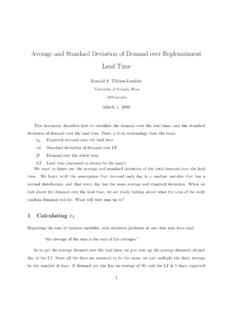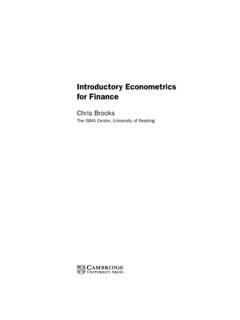Transcription of Forecasting with Seasonality - The College of Business
1 Forecasting with SeasonalityDr. Ron LembkeSept 25, 2015 Forecasting with Seasonality and a trend is obviously more difficult than Forecasting for a trendor for Seasonality by itself, because compensating for both of them is more difficult than either are other methods a person could find to use for taking into account both a trend andseasonality, but the approach we will follow is the following:1. Estimate the amount of Seasonality - the seasonal relatives (or factors or indices)2. Estimate the trend (the rate demand is growing at)3.
2 Make a straight-line prediction of future demand4. Adjust straight-line projection for Seasonality to get a seasonalized forecastUnfortunately, as we will see, we can t just throw all the data into linear regression and seewhat comes out. Linear Regression finds a line of best fit based on minimizing the sum of squarederrors. with seasonal data, some points will be very far away from the trend line, which can skewthe trend line, and give a lowR2value, which will result in us not having a lot of confidence in theLinear Regression values that we would get.
3 Since we are concerned with seasonal demand here,we need to take it into account it in our will use the following terminology:FiForecast of demand in demand in was made at Estimating Seasonal RelativesTo get an estimate of the seasonal relative for each month (or quarter, week, etc., depending onthe data), we need to first talk about Seasonality . Seasonal demand has a pattern that for clothing has a seasonal pattern that repeats every 12 months. Some companies mayanalyze annual seasonal patterns quarterly.
4 The months (or quarters or weeks, etc.) we will referto asperiods. Demand with an annual seasonal pattern has acyclethat is 12 periods long if theperiods are months, or 4 periods long if the periods are quarters. There could also be Seasonality ona smaller time scale, like per week. If you think about the sales at restaurants on campus, Fridays1are probably slower days that Monday through Thursday. And there is even a recurring pattern tosales throughout the seasonal relative (also known as a seasonal index or seasonal factor) is how much the demandfor that particular period tends to be above (or below) the average demand.
5 So to get an accurateestimate of this, we have to get some kind of average for the demand in the first period of the cycle,and the second period, etc., and then compare these average demands per period to some kind ofoverall average demand. This might be the average demand for the past cycle, or over that your demand varies over the course of the year, but that there is no long termgrowth in demand. Suppose we are concerned about how demand goes up or down by quarter. Theway we will look at it, we will ask how much the first quarter s demand is higher or lower than theaverage, and ask the same about the other quarters.
6 To do that, we will compute something calleda seasonal relative. An value of means that the demand for that period is exactly the same asthe average. An value of means the demand is 10% higher than the average, and an value means this period s demand is 15% lower than the Seasonality and a TrendWe will use the data below, shown in Graph 1 as an example. Tthe data clearly has a cycle thatis 4 periods 1: Seasonal DataThe exact sales numbers are2 MonthSales15,38428,081310,28249,15656,11 869,139712,460810,71797,825109,6931115,1 771210, Average MethodTo estimate the seasonal relatives, we are going to do it by averaging the demands each period,and dividing by the overall Cycle 1 Cycle 2 Cycle 3 Average15,3846,1187,8256, ,0819,1399,6938, ,28212,46015,177 12, ,15610,71710,990 10, Average9, we have found what the average demand is for period 1 of a cycle, for period 2, etc.
7 If wedivide these averages by the overall average, we get the following seasonal indices:Period Period Avg Overall AvgIndex16, 9, = , 9, = , 9, = , 9, = Estimating the Growth RateTo estimate the growth rate, we will deseasonalize the individual demand numbers to see howdemands per period go up or Deseasonalizing MethodThe deseasonalizing method uses the seasonal relatives we already created to try to get a picture ofhow much we ve been growing over time. What is deseasonalizing?
8 After we make a straight-lineforecast of the future, we are going to multiply it by the seasonal indices to get a seasonalizedforecast of the is basically the opposite: we are going to take the actual, seasonal data, anddivide it by the seasonal factors to get something that looks more like a straight line. Then we aregoing to do a linear regression through this line. The deseasonalized demands should be a lot morelike a straight line than the original data is, that is, it should generally show a more consistent3growth rate than we see with Seasonality in it.
9 When we do a linear regression through thesedeseasonalized points, the linear regression should give us a pretty good fit through the Seasonal ,384 8, ,081 8, ,282 7, ,156 8, ,118 9, ,139 9, ,460 9, ,717 , ,825 , ,693 = 10, ,177 , ,990 , 2: Seasonal DataIf we do a linear regression through these deseasonalized numbers, we get an intercept of a slope of , and anR2value of For comparison, if we did a Linear Regression onthe original data, we getR2= Straight-Line Projection of Future DemandUse the linear regression calculated previously to extrapolate out into the Linear Forecast17.
10 Making Seasonalized ForecastsMultiply the linear forecast you made by the seasonal factors to get a seasonalized Linear ForecastIndexForecast17, * 5, , * 7, , * = 11, , * 9, , * 6, , * 8, , * = 12, , * = 10, , * 6, , * 9, , * = 14, , * = 12, , * 7, , * = 11, , * = 16, , * = 13, Triple Exponential SmoothingWhen there is a trend and no Seasonality , we used double exponential smoothing, in which wesmoothed our estimates of the trend and the intercept in every period.




